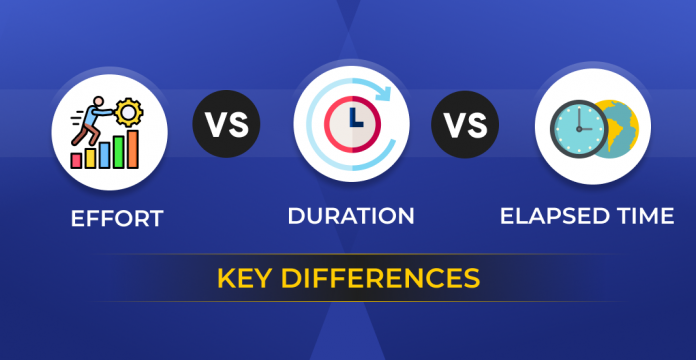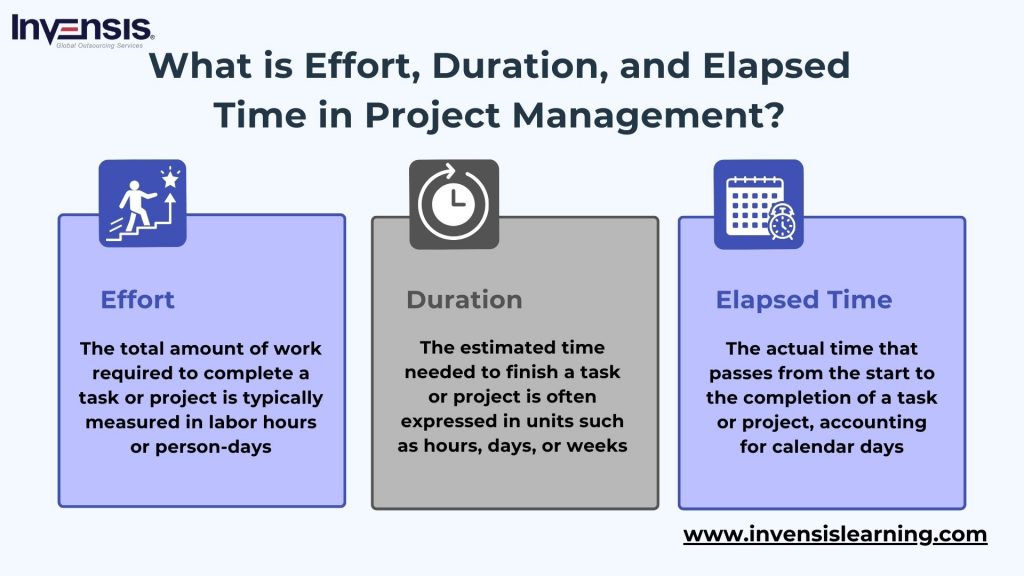
Have you ever felt confused about how long a project will take? The terms effort, duration, and elapsed time are all used interchangeably, but what exactly do they mean? They’re all important concepts in project management, but they describe different things.
This blog provides an in-depth understanding of the differences between effort, duration, and elapsed time, providing clarity to help professionals across various domains navigate their projects precisely.
Through concrete examples and practical explanations, we aim to equip readers with the knowledge and tools necessary to optimize their project planning processes and enhance overall efficiency.
Table of Contents
- What is Effort?
- What is Duration?
- What is Elapsed Time?
- Difference Between Effort, Duration, and Elapsed Time
- Example of Project Effort, Duration and Elapsed Time<
- Conclusion
What is Effort?
Effort denotes the amount of work, time, and resources required to complete a specific task or activity within a project. It encompasses both direct efforts, such as time spent on actual tasks, and indirect efforts, including coordination and administrative tasks.
Accurate estimation of effort is crucial for allocating resources effectively, setting realistic deadlines, monitoring progress, identifying risks, and optimizing performance throughout the project lifecycle.
By understanding and estimating effort accurately, project managers can ensure tasks are completed on time, within budget, and with the desired level of quality, thereby contributing to the successful delivery of the project.
What is Duration?
Duration refers to the total amount of time it takes to complete a specific task, activity, or phase within a project. While effort measures the amount of work involved, duration focuses on the time elapsed from the start to the completion of a task.
Duration is a critical factor in project scheduling, as it helps project managers establish timelines, allocate resources efficiently, and sequence project activities to achieve project objectives within the desired timeframe.
Duration estimates are typically expressed in units of time, such as hours, days, weeks, or months, and are based on factors such as task complexity, resource availability, dependencies, and constraints.
Accurate estimation and management of durations are essential for maintaining project schedules, identifying potential delays, and ensuring timely project delivery.
What is Elapsed Time?
Elapsed time refers to the total duration between initiating and completing a task, activity, or project, encompassing all elapsed hours, days, and non-working periods such as weekends and holidays.
It represents the actual time taken for the task to be accomplished, irrespective of active work periods, making it a fundamental metric for scheduling, resource allocation, and progress tracking in project management certification.
Understanding elapsed time enables project managers to estimate project timelines accurately, allocate resources efficiently, and monitor project progress effectively, thereby aiding in the successful execution of projects.
Difference Between Effort, Duration, and Elapsed Time
Effort, duration, and elapsed time are critical concepts in project management, each representing different aspects of the time and resources required for completing tasks or projects.
Understanding the differences between them is essential for effective planning, scheduling, and tracking progress throughout the project lifecycle.
| Parameter | Effort | Duration | Elapsed Time |
| Definition | Total work hours or labor expended on a task or project. | Total calendar time taken to complete a task or project. | Actual time taken from initiation to completion of a task or project, including all time intervals. |
| Measurement | Labor hours, person-days, or similar metrics. | Days, weeks, months, etc. | Days, weeks, months, etc. |
| Example | If a task requires 20 labor hours to complete, the effort is 20 labor hours. | A task with a 5-day duration is expected to take 5 calendar days to complete. | A task with a 5-day duration might take 7 calendar days to complete due to intervening weekends or holidays. |
| Importance | Crucial for resource estimation and allocation. | Important for project scheduling and setting deadlines. | Essential for tracking actual project execution time. |
Example of Project Effort, Duration, and Elapsed Time
Let’s consider an example to illustrate project effort, duration, and elapsed time:
Imagine a project to develop a mobile application. One of the tasks within this project is “Designing User Interface (UI)“.
- Project Effort: The project effort for designing the UI involves various activities such as brainstorming, creating wireframes, designing graphics, and conducting user testing. Let’s say the estimated effort for this task is 80 person-hours.
- Duration: The duration is the amount of time it will take to complete the task. Let’s assume that the UI design task is estimated to take 2 weeks (10 working days) to complete.
- Elapsed Time: Elapsed time refers to the actual time it takes to complete the task, considering calendar days. Let’s say the UI design task starts on a Monday and ends on the second Friday after that.
Now, let’s break down the example:
- Project Effort: 80 person-hours
- Duration: 2 weeks (10 working days)
- Elapsed Time: If the task starts on Monday and ends on the second Friday after that, the elapsed time would be 11 calendar days (Monday to the following Friday).
Understanding these three aspects helps project managers plan and manage resources effectively, set realistic timelines, and track progress accurately throughout the project lifecycle.
Conclusion
Effort, duration, and elapsed time serve different purposes in project management. Effort quantifies the amount of work required, duration specifies the time needed to complete a task, and elapsed time measures the actual calendar days involved.
Recognizing these differences is essential for accurate planning, resource allocation, and scheduling, enabling project managers to effectively navigate complexities and ensure successful project execution within specified timelines.
By understanding these key differences, project teams can streamline processes, mitigate risks, and enhance overall project outcomes.
Want to improve your project management skills and become a pro at estimating timelines? Invensis Learning offers a variety of Project Management Certification Courses. Sharpen your skills, boost your career prospects, and conquer those project deadlines with confidence!















